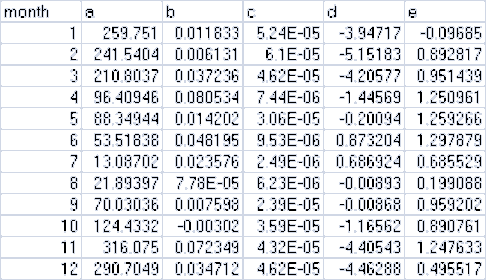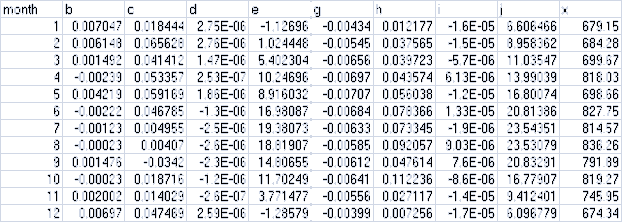Details of Specific Input Data Files
The Flat-Processed DEM File
A spatial data file (.asc) containing elevation values (in meters) for every cell in the simulation area. Theterm “Flat-Processed” indicates that the contents of the file have been pre-processed by the JPDEMflat-processing utility. The DEM file is the “master” film for a simulation run: all other spatially- explicitdata is assumed to have the same row, column, cell size and x, y offset values as the DEM file.
See Creating Flat-Processed DEM Data For The VELMA Simulator and Determining Outletand Watershed Delineationfor details on the use of the JPDEM.jar program to flat process a DEMfile.
The Cover Species ID Map File
A spatial data file (.asc) containing cover species ID numbers for every cell in the simulation area. The IDnumbers must be integers, and must correspond to one or more of the simulator configuration's
/cover/…/uniqueId ID Key values.
The Cover Species Age Map File
A spatial data file (.asc) containing ages (in years) for every cell in the simulation area. The age of a givencell in the file represents that cell's cover species' age in years at the simulation start year (specified inthe simulator configuration by the /calibration/VelmaInputs.properties/syear ID Key's value).
The Soil Parameters ID Map File
A spatial data file (.asc) containing Soil Parameterization ID numbers for every cell in the simulation area. The ID numbers must be integers, and must correspond to one or more of the simulator configuration's /soil/…/uniqueId ID Key values .
The Precipitation Driver Data File
A temporal data file containing a rain value in millimeters for each day of the simulation.
The data is formatted as one value per line in the file, and the file should have as many lines as there are days between the simulator configuration's specified forcing_start and forcing_end values.
For example, if the simulation configuration has the following values specified:
| ID Key | Value |
| /calibration/VelmaInputs.properties/forcing_start | 2000 |
| /calibration/VelmaInputs.properties/forcing_end | 2001 |
| /weather/SpatialWeatherModel/rainDriverDataFileName | MyRainData.csv |
… the VELMA simulator will expect the file MyRainData.csv to contain exactly 731 lines of data (366 days + 365
29.6500000
67.1500000
14.4000000
28.3250000
33.4000000
[ … ]
Notice that although MyRainData.csv is a .csv (comma-separated values) file, it has no header row, and no commas(because there is only one “column” of data). Notice also that there is leading whitespace in front of the datavalues; leading whitespace is not required, and is ignored.
Because there is no difference between a single-column, no-header-row, comma-separated values (.csv) file, and asimple plain text (.txt), the VELMA simulator will accept either a .csv or .txt file extension for theprecipitation driver file, although the .csv extension is preferred.
The Air Temperature Driver Data File
A temporal data file containing a value in centigrade for mean daily temperature (i.e., the average of daily Tminand Tmax) for each day of the simulation. The data is formatted according to the same rules as the precipitationdriver data file; one value per line, one line per possible simulation day.
The Heat Index Map File
A spatial data file (.asc) containing a heat index value for every cell in the simulation area. The heat indexvalue is computed from elevation, slope and other factors.
The Heat Index Map File is only required when the spatially-explicit weather model is used. Otherwise, the filemay be left unspecified in the simulator configuration.
The Precipitation Coefficients File
A comma-separated values (.csv) file containing a table of coefficients for the spatial weather model'sprecipitation equation. The file must contain 13 rows of 6 comma-separated values (columns) each.
The first row is a header row, and the remaining 12 rows provide values for the equation's a, b, c, d and ecoefficients for each month of the year.
Here is an example table of values:

and here are the lines from the corresponding .csv data file:
month,a,b,c,d,e
1,259.751,0.011833,5.24E-05,-3.94717,-0.09685
2,241.5404,0.006131,6.10E-05,-5.15183,0.892817
3,210.8037,0.037236,4.62E-05,-4.20577,0.951439
4,96.40946,0.080534,7.44E-06,-1.44569,1.250961
5,88.34944,0.014202,3.06E-05,-0.20094,1.259266
6,53.51838,0.048195,9.53E-06,0.873204,1.297879
7,13.08702,0.023576,2.49E-06,0.686924,0.685529
8,21.89397,7.78E-05,6.23E-06,-0.00893,0.199088
9,70.03036,0.007598,2.39E-05,-0.00868,0.959202
10,124.4332,-0.00302,3.59E-05,-1.16562,0.890761
11,316.075,0.072349,4.32E-05,-4.40543,1.247633
12,290.7049,0.034712,4.62E-05,-4.46288,0.495517
The Precipitation Coefficients File is only required when the spatially-explicit weather model is used.Otherwise, the file may be left unspecified in the simulator configuration.
The Air Temperature Coefficients File
A comma-separated values (.csv) file containing a table of coefficients for the spatial weather model's airtemperature equation. The file must contain 13 rows of 10 comma-separated values (columns) each. The first rowis a header row, and the remaining 12 rows provide values for the equation's a,..,j and x coefficients for eachmonth of the year.
Here is an example table of values:

and here are the lines from the corresponding .csv data file:
month,b,c,d,e,g,h,i,j,x
1,0.007047,0.018444,2.75E-06,-1.12696,-0.00434,0.012177,-1.60E-05,6.606466,679.15
2,0.006148,0.065628,2.75E-06,1.024448,-0.00545,0.037565,-1.50E-05,8.958362,684.28
3,0.001492,0.041412,1.47E-06,5.402304,-0.00656,0.039723,-5.70E-06,11.03547,699.67
4,-0.00239,0.053357,2.53E-07,10.24696,-0.00697,0.043574,6.13E-06,13.99039,818.03
5,0.004219,0.059169,1.86E-06,8.916032,-0.00707,0.056038,-1.20E-05,16.80074,698.66
6,-0.00222,0.046785,-1.30E-06,16.98087,-0.00684,0.078366,1.33E-05,20.81386,827.75
7,-0.00123,0.004955,-2.50E-06,19.38073,-0.00633,0.073345,-1.90E-06,23.54351,814.57
8,-0.00023,0.00407,-2.60E-06,18.81907,-0.00585,0.092057,9.03E-06,23.53079,836.26
9,0.001476,-0.0342,-2.30E-06,14.80655,-0.00612,0.047614,7.60E-06,20.83291,791.89
10,-0.00023,0.018716,-1.20E-06,11.70249,-0.00641,0.112236,-8.60E-06,16.77907,819.27
11,0.002002,0.014029,-2.60E-07,3.771477,-0.00556,0.027117,-1.40E-05,9.412401,745.95
12,0.00697,0.047469,2.59E-06,-1.28579,-0.00399,0.007256,-1.70E-05,6.096779,674.34
The Air Temperature Coefficients File is only required when the spatially-explicit weather model is used.Otherwise, the file may be left unspecified in the simulator configuration.
The Observed Runoff Data File
An (optional, but recommended) temporal data file containing a runoff value in millimeters for each day of thesimulation. The data is formatted according to the same rules as the precipitation driver data file; one valueper line, one line per possible simulation day. The VELMA simulator engine can run without an observed runoffdata file, but the Nash-Sutcliffe coefficient value automatically computed as part of the simulation resultswill be invalid if the observed runoff data is unavailable.
The Observed Stream Chemistry Data File
An optional temporal data file containing observed DON, NH4, DOC and NO3 loss values for each dayof the simulation. The data is formatted as four comma-separated values per line, one line per possiblesimulation day. The first five lines of an observed stream chemistry data file might look like this:
0.000409543,7.73582E-05,0.013059883,9.10096E-06
4.76427E-05,9.52854E-06,0.002572705,0
9.50966E-05,2.8529E-05,0.006276374,4.75483E-06
4.76506E-05,4.76506E-06,0.002001324,0
4.76506E-05,4.76506E-06,0.001620119,0
[ … ]
In this example snippet, the first day's observed loss values would be:
DON = 0.000409543
NH4 = 7.73582E-05 DOC = 0.013059883 NO3 = 9.10096E-06
Note that, like the Observed Runoff data file, there is no header row (initial line of column header titles) inthe observed stream chemistry file.